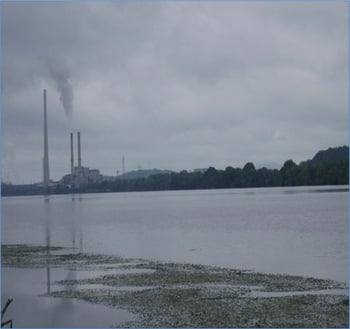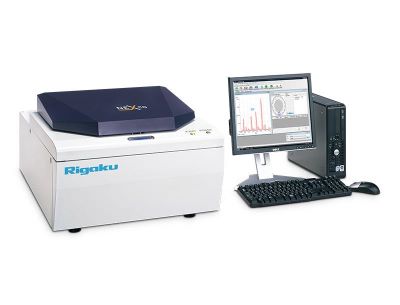Analysis of Heavy Metals in Aerosols on Air Filters
Scope
Measurement of heavy metals in aerosols on air filters is demonstrated. Simple linear empirical calibration is discussed, and performance is shown, for measurement precision and typical detection limits.
Background
 Element analysis of aerosols and particulate matter released in smokestacks, and other industrial gas discharge, is vital to ensure that environmentally acceptable levels of toxic and hazardous elements are released properly into the air. Monitoring smoke or other gaseous waste is important in many areas, such as industrial manufacturing, coal-fired power plants, chemical and plastics production, etc., in order to minimize air pollution and the release of toxic metals in compliance with US EPA and other world and regional or local governing regulations. As a tool to help ensure compliance and proper release, Rigaku offers the NEX CG EDXRF analyzer with polarized and secondary target excitation, giving the analysts and technician alike a fast, simple, yet powerful means of elemental analysis of air filters.
Element analysis of aerosols and particulate matter released in smokestacks, and other industrial gas discharge, is vital to ensure that environmentally acceptable levels of toxic and hazardous elements are released properly into the air. Monitoring smoke or other gaseous waste is important in many areas, such as industrial manufacturing, coal-fired power plants, chemical and plastics production, etc., in order to minimize air pollution and the release of toxic metals in compliance with US EPA and other world and regional or local governing regulations. As a tool to help ensure compliance and proper release, Rigaku offers the NEX CG EDXRF analyzer with polarized and secondary target excitation, giving the analysts and technician alike a fast, simple, yet powerful means of elemental analysis of air filters.
 Model: NEX CG
Model: NEX CG
Calibration
While heavier loadings may require a curved fit, analysis of the typical loadings shown here in the µg/cm² range show a linear XRF response, and so single-point calibrations are suitable. A single-point linear empirical calibration was made for each element using the Standard Value loading levels shown below.
Recovery and repeatability
To demonstrate typical measurement recovery and instrument precision, each calibration standard was measured in 10 repeat analyses.
| Units: µg/cm² | ||||
| Element | Standard value | Average value | Standard deviation | % RSD |
| Cr | 46.0 | 46.19 | 0.15 | 0.3 |
| Ga | 51.0 | 51.64 | 0.15 | 0.3 |
| As | 51.0 | 51.81 | 0.06 | 0.1 |
| Se | 48.6 | 48.72 | 0.09 | 0.2 |
| Ag | 22.6 | 22.31 | 0.01 | 0.1 |
| Cd | 48.6 | 48.74 | 0.19 | 0.4 |
| Ba | 41.1 | 41.10 | 0.09 | 0.2 |
| Pb | 63.0 | 63.33 | 0.07 | 0.1 |
Conclusion
The Rigaku NEX CG combines secondary target excitation with a high performance SDD detector, to deliver optimal EDXRF sensitivity for the measurement of metals in aerosols on air filters. The NEX CG analyzer is capable of elemental analysis from Na – U, making the XRF technique ideal for other elements on air filters, as well. For the measurement of light elements Na-Cl, helium purge or vacuum is used to remove air from the optical path and optimize analysis sensitivity. Elements near argon, which is about 1% of the total composition of air, require evacuation of the air using the NEX CG vacuum option to fully eliminate the background caused by the argon peak. Such elements include K, Ag, Cd, In and Sn. All other elements with emission lines above 3.5 keV can be easily measured in air. The NEX CG can be equipped to analyze in air, helium purge or vacuum.
The NEX CG analyzer also gives the user a very versatile tool not only for monitory air filters, but also elemental analysis of solids, powders and liquids. And coupled with the Rigaku UltraCarry® aqueous sample preparation system, NEX CG can be used to monitor effluent and wastewater discharge to the sub-ppm levels. This power and simplicity makes the analyzer an important tool to help ensure industrial processes are environmentally sound and meet regulatory compliance.
References
The following citations provide background data for the application:
- Elemental Analysis of PM2.5 with energy dispersive X-ray spectrometer NEX CG. Morikawa, Atsushi. Rigaku Journal. 2014: 30(2): 13-17
- Sputnik-generated multi-element aerosol-on-filter standards for XRF measurement of harmful elements in workplace air. Robert D. Foster. X-Ray Spectrometry. 2000; 29 (6): 467-474.
- A comparison of X-ray fluorescence and wet chemical analysis for lead on air filters from different personal samplers used in a secondary lead smelter/solder manufacturer. Martin Harper and Bruce Pacolay. Environ. Monit. 2006; 8: 140-146.
- A comparison of portable XRF and ICP-OES analysis for lead on air filter samples from a lead ore concentrator mill and a lead-acid battery recycler. Martin Harper, Bruce Pacolay, Patrick Hintz and Michael E. Andrew. Environ. Monit. 2006; 8: 384-392.
- Elemental Analysis of Airborne Particles. Landsberger, Sheldon, and Marsha Creatchman. Amsterdam, Netherlands: Gordon and Breach Science, 1999. Print.
- A comparison of X-ray fluorescence and wet chemical analysis of air filter samples from a scrap lead smelting operation. Environ. Monit. 2004; 6: 819-826.
- Application of an energy dispersive x-ray fluorescence spectrometer to air pollution studies. M Öblad, P Standzenieks, E Selin and J Dubois. Scr. 1982; 26: 257.

Contact Us
Whether you're interested in getting a quote, want a demo, need technical support, or simply have a question, we're here to help.
